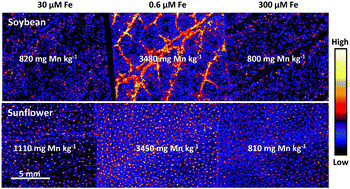Evaluating effects of iron on manganese toxicity in soybean and sunflower using synchrotron-based X-ray fluorescence microscopy and X-ray absorption spectroscopy†
Abstract
With similar chemistry, Mn and Fe interact in their many essential roles in plants but the magnitude and mechanisms involved of these interactions are poorly understood. Leaves of soybean (a Mn-sensitive species) developed a mild chlorosis and small dark spots and distorted trifoliate leaves with 30 μM Mn and 0.6 μM Fe in nutrient solution (pH 5.6; 3 mM ionic strength). At 0.6 μM Fe, lower alternate leaves of sunflower (a Mn-tolerant species) were chlorotic at 30 μM Mn and had a pale chlorosis and necrosis at 400 μM Mn. A concentration of 30 and 300 μM Fe in solution alleviated these typical symptoms of Mn toxicity and decreased the concentration of Mn from >3000 to ca. 800 mg kg−1 dry mass (DM) in all leaf tissues. As expected, increased Fe supply increased Fe in leaves from <100 up to 1350 mg Fe kg−1 DM. In situ synchrotron-based X-ray fluorescence microscopy showed that increased Fe supply caused an overall decrease in Mn in the leaf tissue but had little effect on the pattern of its distribution. Similarly, X-ray absorption spectroscopy identified only slight effects of Fe supply on Mn speciation in leaf tissues. Thus, the results of this study indicate that increased Fe supply ameliorated Mn toxicity in soybean and sunflower largely through decreased Mn uptake and translocation to leaf tissues rather than through changes in Mn distribution or speciation within the leaves.

- This article is part of the themed collection: Phytometallomics


 Please wait while we load your content...
Please wait while we load your content...